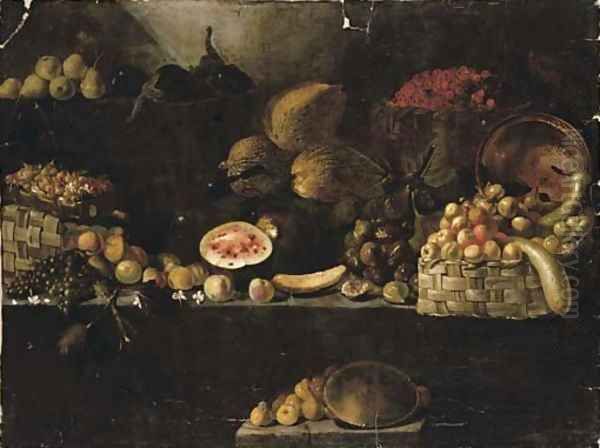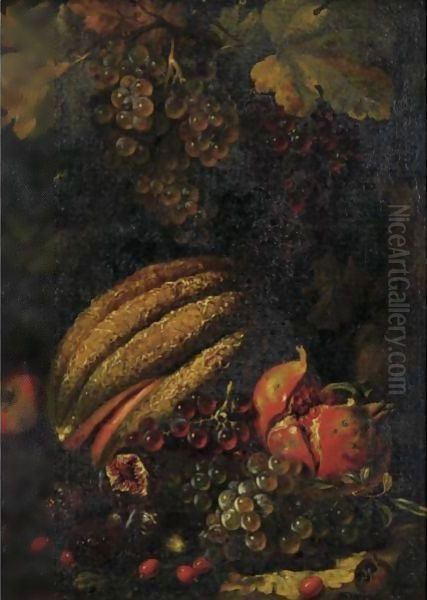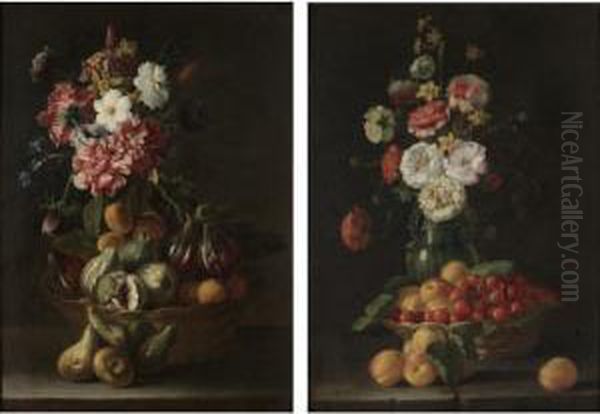Luca Forte, a prominent figure in the vibrant artistic milieu of 17th-century Naples, stands as a testament to the burgeoning genre of still life painting. Active roughly between 1615 and 1670, Forte is widely recognized as one of the foundational artists who shaped the distinctive character of Neapolitan still life. His work, deeply imbued with a naturalistic vigor, not only captured the opulence of nature's bounty but also reflected the complex artistic exchanges of his time, bridging Italian traditions with influences from Spain and Northern Europe.
The Neapolitan Crucible: An Artist's Emergence
Naples in the early 17th century was a bustling metropolis, a jewel in the Spanish crown, and a fertile ground for artistic innovation. The city throbbed with a unique energy, a blend of Mediterranean exuberance and Spanish gravitas. It was in this dynamic environment that Luca Forte honed his craft. While precise details of his early training remain somewhat elusive, as is common for many artists of this period, his artistic trajectory clearly points to a profound engagement with the prevailing currents of naturalism.
The shadow of Michelangelo Merisi da Caravaggio loomed large over Naples. Caravaggio's brief but impactful sojourns in the city (1606-1607 and 1609-1610) had irrevocably altered its artistic landscape. His revolutionary approach to realism, his dramatic use of chiaroscuro (the interplay of light and shadow, often termed tenebrism), and his unidealized depiction of subjects resonated deeply with Neapolitan painters. Forte, emerging in the decades following Caravaggio's presence, absorbed this legacy, translating its principles into the specialized realm of still life.
Caravaggesque Roots and Roman Connections
The influence of Caravaggio's naturalism is a cornerstone of Forte's art. His compositions often feature fruits, flowers, and other objects rendered with a palpable sense of texture and volume, illuminated by a strong, directional light that carves them out from shadowy backgrounds. This approach lent a dramatic intensity and a tactile reality to his subjects, moving beyond mere decoration to evoke a deeper appreciation for the transient beauty of the natural world.

Forte's artistic vision was also shaped by contemporary developments in Rome, the artistic epicenter of Italy. He is believed to have been influenced by Roman artists who were themselves grappling with Caravaggio's legacy and pioneering new forms of still life. Among these figures were Tommaso Salini (c. 1575–1625), an early exponent of Caravaggesque still life, and Giovanni Battista Crescenzi (1577–1635), a painter, architect, and influential patron who played a role in promoting naturalistic painting. Another Roman artist whose work likely informed Forte was Pietro Paolo Bonzi, also known as Gobbo dei Carracci or Gobbo dei Frutti (c. 1576–1636), celebrated for his fruit and vegetable still lifes. These Roman connections provided Forte with models for composing still lifes that were both naturalistic and artfully arranged.
Spanish Affinities and International Currents
The political ties between Naples and Spain facilitated a rich artistic dialogue. Spanish artists were present in Naples, and Neapolitan works found their way to Spain. Forte's art shows an awareness of Spanish still life traditions, particularly the work of artists like Blas de Ledesma (active early 17th century), known for his meticulously detailed depictions of fruits and sweets, and Juan van der Hamen y León (1596–1631), a leading master of Spanish still life whose elegant and structured compositions were highly influential. The clarity and ordered arrangement seen in some of Forte's works may echo the sensibilities of these Spanish painters.
Furthermore, Naples was a cosmopolitan port city, and the influence of Flemish still life, with its emphasis on rich detail and varied textures, cannot be discounted. Though not explicitly documented as a direct teacher, the general atmosphere would have included exposure to such works, perhaps through collections or itinerant artists. The meticulous rendering of surfaces, from the downy skin of a peach to the glistening dew on a grape, suggests an appreciation for the detailed realism championed by Northern European painters like Frans Snyders (1579–1657) or Osias Beert (c. 1580–1624), whose works were becoming known across Europe.
The Flourishing of Still Life: Forte's Signature Style
Luca Forte's contribution was pivotal in establishing still life as a respected and independent genre in Naples. He moved beyond the simpler, more austere arrangements of earlier still life painters, developing compositions that were often more abundant and complex. His paintings typically feature a profusion of fruits – grapes, figs, pomegranates, apples, pears – often spilling from baskets or arranged on stone ledges. Flowers, too, appear in his works, rendered with botanical accuracy and vibrant color.

A key characteristic of Forte's style is his masterful handling of light. He used it not just to illuminate but to model form, to create a sense of depth, and to highlight the diverse textures of his subjects. The interplay of light and shadow creates a sense of drama and immediacy, drawing the viewer into the scene. His brushwork could be both precise, capturing minute details, and somewhat broader, conveying the succulence of fruit or the delicacy of a petal.
Among his representative works, paintings such as "Still Life with Fruit and Grapes" exemplify his skill. These compositions are often characterized by a rich, earthy palette, enlivened by the vibrant hues of the fruits themselves. Another notable piece often attributed to him or his circle is "Still Life of Apples and Pears" (c. 1625-1635), which showcases his ability to convey the weight and solidity of the fruit. The "Basket of Fruit with Fruit" (c. 1640-1647) is lauded for its complex arrangement and technical virtuosity, demonstrating Forte's mature command of the genre.
Collaboration and Artistic Circles: Aniello Falcone
Forte was an active participant in the Neapolitan art scene and maintained connections with fellow artists. His most significant documented association was with Aniello Falcone (1607–1656), a renowned painter of battle scenes and a prominent figure in Neapolitan Caravaggism. Falcone's studio was more than just a workshop; it functioned as a design academy and a school for life drawing, attracting numerous artists.
Documentary evidence confirms the close ties between Forte and Falcone. In 1639, Forte served as a witness at Falcone's marriage contract, a testament to their personal and professional relationship. This connection extended to artistic collaboration. It was not uncommon during this period for specialists to collaborate on a single canvas, with one artist painting the figures and another the landscape or still life elements.
Historical records, such as the 1654 inventory of the collection of Ferrante Spinelli, Prince of Tarsia, mention collaborative works where Forte was responsible for the flowers and fruits, while Falcone painted the figures. One such painting, often identified as "Still Life with Fruit," is now housed in the Prado Museum in Madrid. This collaboration likely occurred during the 1630s and 1640s, a period of intense activity for both artists. Such partnerships allowed each artist to contribute their specific expertise, resulting in works of composite richness. Falcone's robust, naturalistic figures would have complemented Forte's lush and tangible still life elements.
Patronage, Market, and Dissemination

Luca Forte's paintings were highly sought after by collectors, both in Naples and beyond. The city's affluent aristocracy, wealthy merchants, and Spanish administrators provided a ready market for luxury goods, including art. Still life paintings, with their celebration of nature's abundance and their often symbolic undertones (alluding to themes of transience, vanitas, or the bounty of creation), appealed to the tastes of the time.
Forte's works commanded significant prices, reflecting his esteemed reputation. For instance, a still life he painted for Don Antonio Ruffo, a prominent Sicilian nobleman and discerning collector who also patronized Rembrandt, was valued at a substantial 200 ducats. This indicates the high regard in which Forte's art was held and its commercial success.
The dissemination of Forte's work was facilitated by art dealers and collectors with international connections. Figures like Giacomo de Castro, Gaspare Roomer, and Ferdinand Vandeneynden played crucial roles in the Neapolitan art market. Roomer and Vandeneynden, Flemish merchants based in Naples, were particularly influential collectors and patrons whose tastes helped shape artistic trends and whose networks helped spread Neapolitan art across Europe. Through such channels, Forte's paintings reached collections in Spain, the Netherlands, and other parts of Italy, contributing to the broader European appreciation for Neapolitan still life.
The Challenge of Attribution and Artistic Legacy
Despite his significance, relatively few works by Luca Forte bear his signature or monogram ("LF" or "L.F."). This scarcity of signed pieces presents challenges for art historians in definitively attributing paintings to his hand. Attributions are often made based on stylistic analysis, comparison with documented works, and an understanding of his known collaborations and influences. The meticulous detail, the characteristic handling of light and texture, and the specific types of compositions are key indicators used by scholars.
The difficulty in attribution is compounded by the fact that Forte was a foundational figure whose style influenced a generation of Neapolitan still life painters. His innovations were adopted and adapted by his followers, sometimes making it difficult to distinguish the master's work from that of his close contemporaries or pupils.
Nevertheless, Luca Forte's impact on the development of Neapolitan still life painting is undeniable. He helped to elevate the genre, infusing it with a Caravaggesque intensity and a sophisticated sense of composition. His work laid the groundwork for subsequent masters of Neapolitan still life, such as the Recco family – Giovan Battista Recco (active c. 1615-1660) and his more famous nephew Giuseppe Recco (1634–1695) – and Paolo Porpora (1617–1673), who further developed the genre, often with even greater exuberance and complexity. Even artists like Abraham Brueghel (1631-1697), a Flemish painter who spent a significant part of his career in Naples, built upon the traditions established by pioneers like Forte. The influence of Jusepe de Ribera (1591-1652), the Spanish-born titan of Neapolitan painting, while primarily in figurative work, also contributed to the overall climate of intense naturalism that Forte embraced for still life.
Enduring Significance
Luca Forte's career, though perhaps not as extensively documented as some of his contemporaries, was pivotal. He was a key figure in the "Golden Age" of Neapolitan painting, a period marked by extraordinary artistic vitality. By synthesizing the dramatic naturalism of Caravaggio with influences from Roman and Spanish art, and possibly even Northern European traditions, he forged a distinctive style of still life that was both visually compelling and deeply rooted in the observation of nature.
His ability to render the textures, colors, and forms of fruits and flowers with such vividness transformed humble subjects into objects of aesthetic contemplation. His works speak to a society that appreciated both the beauty of the everyday and the skill of the artist capable of capturing it with such fidelity. Through his art, Luca Forte not only celebrated the bounty of the Neapolitan landscape but also made a lasting contribution to the history of still life painting, securing his place as a true innovator and a master of the genre. His legacy endures in the rich tradition of Neapolitan still life that flourished in his wake, a tradition he so expertly helped to inaugurate.